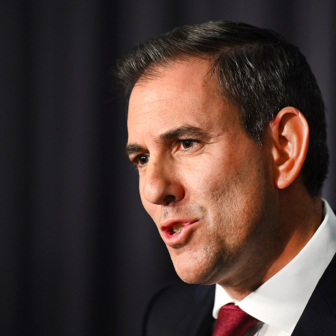THE breakdown of the UN-based treaties, targets and trading model of climate policy, which I charted in the first of this two-part series, is disappointing in its own terms. It also has grave implications for Australian climate policy, which has been fashioned to fit that “3Ts” model of global action.
Since its earliest design phases, the federal government’s emissions trading policy has been based on the fundamental assumption that global climate cooperation will evolve along the lines of the 3Ts model. The 2008 Garnaut Review recommended that Australia play its “full proportionate part” in a global emissions reduction treaty designed to keep atmospheric greenhouse gas concentrations below 450 parts per million carbon dioxide-equivalent (a so-called “450 Agreement”). This equated, in Professor Garnaut’s view, with a target of 25 per cent reduction in Australia’s emissions below 2000 levels by 2020, and 90 per cent by 2050. (Professor Garnaut believed a “550 ppm agreement” was more likely, in which case Australia’s 2020 targets should be 10 per cent and 80 per cent below 2000 levels by 2020 and 2050, respectively.) That target should then be met at the lowest possible cost through an emissions trading scheme, said Garnaut, which could form the basis for countries to trade their “emissions entitlements” on evolving international carbon markets.
At the time, Garnaut shared the prevailing wisdom among much of the Australian and international climate policy community that an international treaty would likely be agreed and that it would be comprehensive. It would impose binding emissions reduction obligations on all or most emitters. These obligations would “add-up” to a “parts-per-million” climatic outcome and – because accounting rules would stipulate the domestically produced emissions for which each country is responsible – they would be seamless. An international carbon market would enable countries to trade their entitlements so as to minimise costs, and this regime would be backed by highly effective regulatory and enforcement mechanisms.
Since the climate problem could be “solved” at the international level through the comprehensive international regime, all that remained for Australia to do was to negotiate its preferred target and then meet that target via its own emissions trading scheme – the invisible hand of the global carbon market would take care of the rest.
Despite the failures in Copenhagen and beyond, the government’s Clean Energy Future policy continues to be based largely on the 3Ts model. Its centrepiece, the carbon pricing scheme passed into law last November, is replete with features that depend for their policy integrity on the conclusion of a comprehensive international emissions reduction treaty of the kind envisaged by Garnaut, for which many in the international community still hold out hope.
The feature of the carbon pricing scheme that most obviously reflects this model is the automatic transition from a fixed, rising carbon price to a floating price on 1 July 2015. In the floating price phase, the carbon price will be set (subject to the price collar arrangements discussed below) by the market demand for a capped supply of carbon permits. The “cap” is, in turn, based on Australia’s 2020 emissions reduction target. The Australian government has pledged to reduce Australia’s emissions: by 5 per cent below 2000 levels by 2020, unconditionally; by 15 per cent below 2000 levels by 2020 if there is a global agreement that falls short of 450ppm under which “major developing economies commit to substantially restraining their emissions and advanced economies take on commitments comparable to Australia’s”; and by 25 per cent below 2000 levels by 2020 if there is a “450 Agreement.”
Given that neither a 450 agreement nor a lesser agreement that meets the conditions for a 15 per cent target has any chance of being negotiated (remembering that the earliest any significant agreement could come into effect, based on the Durban Roadmap, is 2020), the government will set emissions caps based on its unconditional offer of 5 per cent emissions reductions below 2000 levels by 2020. But Australia’s target is completely arbitrary if it is not plugged into to a global regime of targets that “adds up” to a desirable climatic outcome. Focusing exclusively on meeting such an arbitrary target is the climate policy equivalent of plugging your toaster into thin air and expecting your toast to be golden brown.
Another aspect of Australia’s scheme predicated on the success of the 3Ts model is the mechanism that allows liable entities to outsource emissions reduction obligations by purchasing cheaper international offsets. From the beginning of the floating price phase until 2020, liable entities will be able to acquit up to 50 per cent of their annual liability using these international “offsets” (whether the 50 per cent limitation will be continued beyond 2020 will be “reviewed” by the Climate Change Authority in 2016). Offsetting is part and parcel of the economistic theory behind the 3Ts model, according to which emissions reductions should occur where they are cheapest. If emissions could be cut more cheaply in China, for example, then it is “more efficient” for Australia to pay China to cut its emissions, allowing Australia to pollute more.
But the implications of recent climate science are that we must reduce global emissions (and hence those of every country) rapidly to zero or near zero, and that we must greatly expand the world’s carbon sinks (which suck carbon dioxide out of the atmosphere). This reality exposes the unscientific basis of the 3Ts model and its ideal-theoretic manifestation, the “global carbon market.” The fact that Australia’s scheme allows the use of international offsets in these circumstances – making it likely Australia’s emissions will actually rise over the next ten years and hardly decline at all over the next forty years – is a travesty of public policy.
A third way in which Australia’s embrace of the 3Ts model manifests itself is in the functions of some of the institutions that will manage the carbon pricing scheme. The Climate Change Authority, for example, will monitor the evolution of international climate negotiations and carbon markets and must consider such analysis in setting its proposed emissions caps for the scheme. Moreover, the Productivity Commission, in determining whether the government’s hand-outs to emissions-intensive trade exposed industries should be changed, must consider whether foreign countries “responsible for the substantial majority of the world’s emissions” have implemented emissions reduction measures with comparable impacts to those in Australia, and the extent to which foreign countries generally have implemented such measures.
But it is perhaps what is left out of the Clean Energy Future package that most clearly demonstrates the extent to which Australia is wedded to the 3Ts model. Not only are Australia’s fossil fuel exports effectively excluded from the carbon pricing scheme, but the Australian government actively supports the massive expansion of coal and gas projects for export. Under UN accounting rules, the emissions embodied in exported fossil fuels don’t count towards the exporting country’s emissions reduction accounts (and hence targets); rather, those emissions are accounted for by the importing country that ultimately combusts the fossil fuels. This approach also accords with the economic theory on which the 3Ts model is based. But in the real world, where the 3Ts model has collapsed, much of the world’s fossil fuel – and much of Australia’s – is exported to countries that do not have, and are not likely to have, emissions reduction targets. Any country genuinely concerned about climate change would take action to curb this irresponsible fossil fuel expansionism. That the Australian government so blatantly exploits this loophole while claiming that such conduct is acceptable because it accords with UN accounting rules reveals both the expediency and the absurdity of Australia’s reliance on the 3Ts model.
Australia’s lack of reliance on clean energy support mechanisms is further symptomatic of our faith in the 3Ts. After all, why would we need to support renewable energy when the global carbon market will ensure that emissions are reduced at the lowest possible cost? Of course, the weak and arbitrary emissions reduction target and the reliance on international offsets will mean that Australian carbon is grossly under-priced, with the result that the carbon price alone will not stimulate sufficient investment in renewable energy and other clean technologies. The Clean Energy Future Package does contain some additional measures (beyond the existing 20 per cent renewable energy target) that will assist in promoting research, development and deployment in clean technologies. But these measures were largely wrestled out of the government by the Greens and sit awkwardly with the puritanical emissions trading model into which the carbon pricing scheme will rapidly transition. They are anomalies in the 3Ts paradigm that serve only to highlight its flaws.
Australia must adjust to the reality that the international policy model on which it has based its domestic climate policy is in tatters. In the years ahead, immense reductions in greenhouse gas emissions will need to be made by countries including Australia in the context of weaker and less elegant forms of international cooperation than the boffins behind the 3Ts model hoped for. As the carbon pricing scheme cranks into action in the coming months and years, the incongruence between their ideal world and the real world will become increasingly apparent. •




